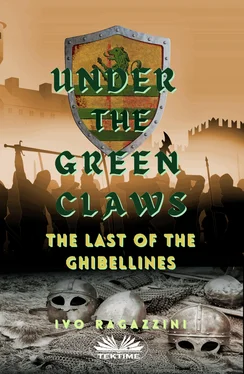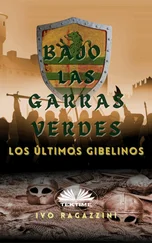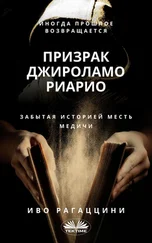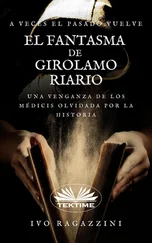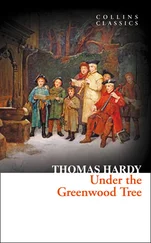Ivo Ragazzini - Under The Green Claws
Здесь есть возможность читать онлайн «Ivo Ragazzini - Under The Green Claws» — ознакомительный отрывок электронной книги совершенно бесплатно, а после прочтения отрывка купить полную версию. В некоторых случаях можно слушать аудио, скачать через торрент в формате fb2 и присутствует краткое содержание. Жанр: unrecognised, на английском языке. Описание произведения, (предисловие) а так же отзывы посетителей доступны на портале библиотеки ЛибКат.
- Название:Under The Green Claws
- Автор:
- Жанр:
- Год:неизвестен
- ISBN:нет данных
- Рейтинг книги:5 / 5. Голосов: 1
-
Избранное:Добавить в избранное
- Отзывы:
-
Ваша оценка:
- 100
- 1
- 2
- 3
- 4
- 5
Under The Green Claws: краткое содержание, описание и аннотация
Предлагаем к чтению аннотацию, описание, краткое содержание или предисловие (зависит от того, что написал сам автор книги «Under The Green Claws»). Если вы не нашли необходимую информацию о книге — напишите в комментариях, мы постараемся отыскать её.
Under The Green Claws — читать онлайн ознакомительный отрывок
Ниже представлен текст книги, разбитый по страницам. Система сохранения места последней прочитанной страницы, позволяет с удобством читать онлайн бесплатно книгу «Under The Green Claws», без необходимости каждый раз заново искать на чём Вы остановились. Поставьте закладку, и сможете в любой момент перейти на страницу, на которой закончили чтение.
Интервал:
Закладка:
"After so many centuries none should believe in these heresies anymore, Eminence, but traditions and superstitions that are rooted in the population cannot be eradicated with arguments of faith or reason. Many Christians, including priests and bishops, bless them and still celebrate them as Christian holidays without knowing anything about their true origins," said the historian.
"And how do you fight these things then, if someone wanted to fight them?" the pope asked again.
"It is possible to deviate, or rather, gradually pilot their false pagan festivals and traditions towards other similar Christian festivals and traditions, as has already been done in the past with other places and personalities, to the point of completely replacing them with ceremonies that are more suited to Christian peoples as has been done with Candlemas, which is also known as the feast of the candles of our Most Holy Virgin Mother."
The pope cut him short, "So let it take root in Forolivii and in Romandiola, and then baptize all of them and establish papal legates to whom allegiance can be sworn, since that land has been ceded to us by the Emperor Rudolph of Alemania 14and is now ours."
"The question is a little more complex, Eminence..." said the historian.
"Explain this to me."
"They, unlike others, have already refused to elect the Most Holy Virgin Mary of Candlemas as their patron, claiming their patron to be an ancient priestess called Livia Drusilla, Diva Augusta 15and protector of these sites and they do the same in the salt pans of Cervia, when they transport the sacred salt they produce in that place, to celebrate this Roman patroness."
"Sacred salt? Diva Augusta?"
"Yes, Eminence, those saltpans were founded by Livio Salinatore, an ancient ancestor of this Livia Drusilla, and still today they send salt from there, during a sacred procession to that city for the feasts to honor her."
"And how can they still believe these things after centuries?" the pope laughed quietly.
"Well, Eminence, you should know that this Livia Drusilla was not a common priestess but the wife of Octavian Augustus and, in Forolivia, some still wish to remember her as such and to keep her as protector, even if it is partially hidden by them, replied the papal historian.
"How do you know all this?"
"I learned everything from a friar of a particular religious order that was founded in Ravenna by Emperor Otto III two hundred years ago, a very good friend of Geremia Gotto and Guido Bonatti."
"Geremia Gotto and Guido Bonatti? The armed patarines 16who claim to be four hundred years old and Frederick II's Ghibelline astrologer?" exclaimed the pope.
"In person, Excellency, and they are both in Forlì among the ranks of the Ghibelline in the service of Guido da Montefeltro."
"Oh dear, the excommunicated captain of the Ghibellines?"
"Yes, Excellency!"
"But are they all that mad!"
"Indeed, Excellency, they are a little peculiar."
"You also spoke of a religious order founded by Emperor Otto III in Ravenna. What religious order are you talking about?" asked the pope.
"In Ravenna, Otto III founded a religious group with all practices and beliefs that still seem to be extant today."
"What practices and beliefs do they follow?"
"They seem to affirm the reincarnation and pre-existence of souls."
"Oh, there you are. Gnostic heresy. 17Is that why they say he is four hundred years old?"
"That may be so, Otto III was that young emperor who two centuries ago claimed to have been Charlemagne and appointed an antipope named Sylvester II to be re-elected as Constantine the Great, the legitimate heir of the Roman Empire," replied the historian.
"Charlemagne, Constantine? Would you like to explain better what he did?" asked the pope.
"Certainly, Excellency. Otto III, around the year 1000, entered the Aachen cathedral, marked a point on the floor, then took a pickaxe, began to break through the floor and found the body of Charlemagne underground, it was still intact sitting on a throne, adorned and all decked out as a bishop, holding the Gospel in one hand and the staff of command in the other."
"And why did he do this?"
"Because he said he was his reincarnation and that he had returned to take his place as Holy Roman Emperor."
"And then?"
"He took the bishop's tiara that Charlemagne had on his head and put it on his own, then took Charlemagne's staff of command and said he had returned to rule."
"And then?" the pope asked more and more incredulously.
"Then, still not happy, he went to Ravenna and founded this particular religious group and appointed the bishop of Ravenna antipope, with the name of Sylvester II, to crown him emperor, exactly as Pope Sylvester had crowned Constantine emperor of the Christians, seven centuries earlier, at the time of ancient Rome," explained the historian.
"And why did he create this final scene?"
"To make everyone believe he was also the reincarnation of Constantine and to take back what he considered to be his property, that is the territories the church was trying to take from him, the empire, thanks to the gift of Constantine. "
"And so he said he was the reincarnation of Charlemagne and Constantine to take the land back from the Holy Roman Empire?" exclaimed the pope.
"Those, Your Holiness."
"Those who?"
"Frederick Barbarossa and Frederick II also exhumed the body of Charlemagne and proclaimed something like this. And I would bet that this tradition has also been handed down to the astrologer Guido Bonatti and to Friar Geremia Gotto." 18
"But these are all crazy."
"I told you, Excellency, that they were a little particular," concluded the historian.
4. Confrontations between the Guelphs and Ghibellines in Romagna
But why did the Church want Romagna?
What had happened between the papacy and emperors in those times?
Let's go back a few decades and take a look at a chronicle of the time.
Romagna in 1200
Although Pepin King of the Franks 19had given Romagna to the Church almost five centuries earlier, it was never perfectly under its possession. Often, therefore, many places in Romagna almost always joined the empire and towards the mid 1200s Gregory IX tried to take it back by force of arms. Because of the disagreements between Emperor Frederick II and the Church, 20the people of Romagna were also split between the Ghibellines and Guelphs as happened with many other peoples in Italy.
The residents of Forlì continued to obey the laws of the empire, while the residents of Faenza and Ravenna obeyed those of the Church.
Forlì, formerly named Forum Livii , in particular, was one of the most Ghibelline city in Italy and it was not a coincidence that Guido Bonatti, one of the best astrologers of his time, despite being born in Florence, requested and obtained citizenship of Forlì, believing that location to be the final place left in the world that maintained imperial traditions after the fall of the ancient empire of Rome, for reasons that you will soon discover for yourself.
In 1240, when Pietro Traversari died, who was the leader of the Guelphs of Romagna and lord of Ravenna, 21Ravenna and Faenza were conquered by Frederick II who went to Romagna and one after the other put siege to them.
In less than a week Ravenna fell and surrendered.
Now it was Faenza's turn to surrender, but the city, believing that Frederick II's forces were insufficient to cause it to capitulate, did not surrender and the emperor placed it under siege.
5. The siege of Faenza
Faenza resisted for seven months, infuriating Frederick himself, since years before he had already conquered the town and it had come to terms with him.
Furthermore, during the siege Frederick II ran out of gold and money and had to resort to the help of the Forlì people to conquer Faenza, he also requested the Forlì people to issue special augustarians 22in leather, equivalent to imperial gold coins, which he then repaid in gold to the inhabitants of Forlì once the town had been taken and sacked.
Читать дальшеИнтервал:
Закладка:
Похожие книги на «Under The Green Claws»
Представляем Вашему вниманию похожие книги на «Under The Green Claws» списком для выбора. Мы отобрали схожую по названию и смыслу литературу в надежде предоставить читателям больше вариантов отыскать новые, интересные, ещё непрочитанные произведения.
Обсуждение, отзывы о книге «Under The Green Claws» и просто собственные мнения читателей. Оставьте ваши комментарии, напишите, что Вы думаете о произведении, его смысле или главных героях. Укажите что конкретно понравилось, а что нет, и почему Вы так считаете.
